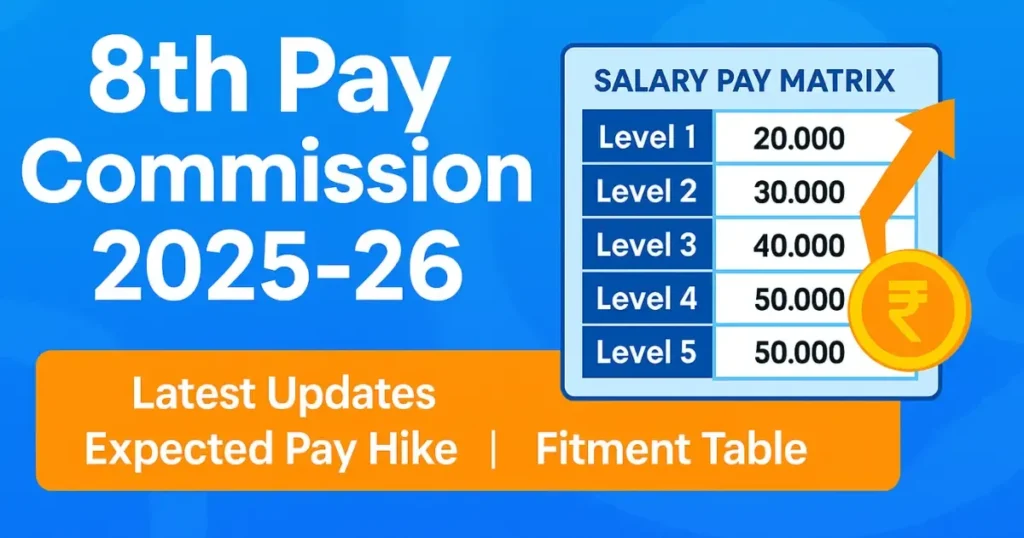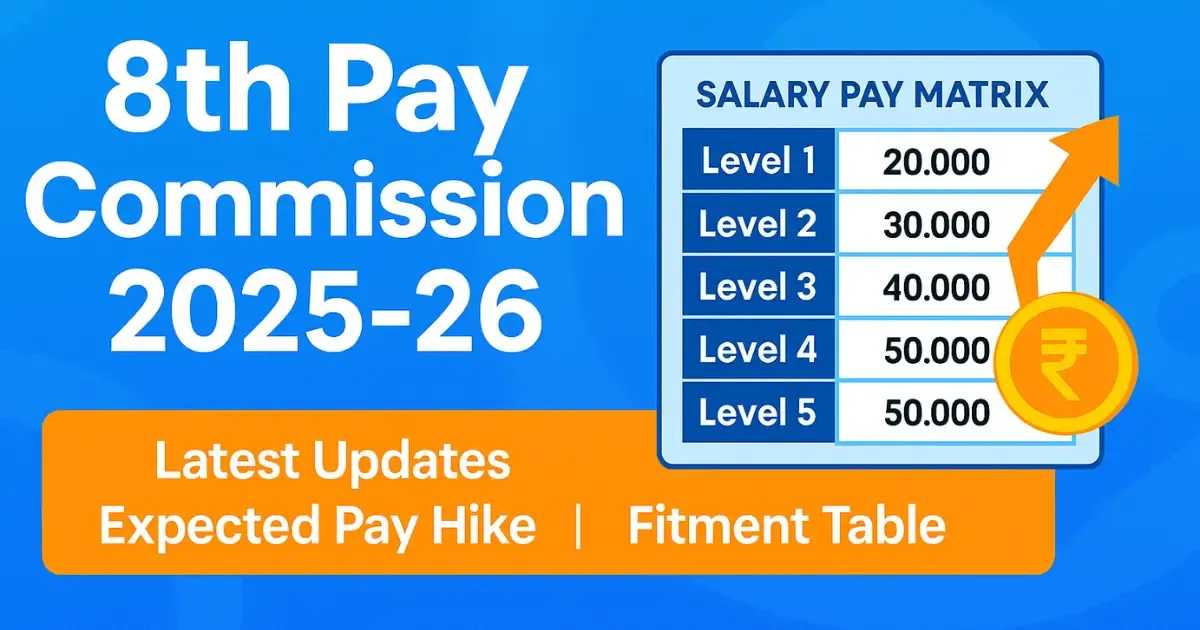The 8th Pay Commission is expected to be a major financial reform in India, especially for central government employees and pensioners. One of the most crucial components of the Pay Commission is the salary fitment factor, which determines the multiplication of existing basic pay to arrive at the new revised salary structure.
This comprehensive article will cover everything about the 8th Pay Commission salary fitment factor, including:
- What is a fitment factor?
- Past pay commission fitment trends
- Expected fitment factor in the 8th CPC
- Calculation formula and examples
- Probable implementation timeline
- Impact on allowances, pensions, and salary
- Frequently asked questions

🔹 What is Fitment Factor in Pay Commission?
The fitment factor is a multiplier used to revise the basic salary of government employees under a new pay commission.
It is applied as:
New Basic Pay = Old Basic Pay × Fitment Factor
This factor ensures uniform salary hikes across all pay levels without restructuring each pay band individually.
🔹 Fitment Factors in Past Pay Commissions (Table)
| Pay Commission | Year of Implementation | Fitment Factor | Basic Pay Hike % |
|---|---|---|---|
| 5th CPC | 1996 | 3.57x approx | ~300% |
| 6th CPC | 2006 | 1.86x | ~86% |
| 7th CPC | 2016 | 2.57x | ~57% |
| 8th CPC (Expected) | 2026 (tentative) | 3.68x (expected) | ~68% (expected) |
🔍 Key Insight: Each commission shows a declining hike percentage, but the absolute increase in rupee terms is higher due to inflation and living costs.
🔹 Why is Fitment Factor So Important?
The fitment factor:
- Directly impacts take-home salary
- Affects pension revision
- Impacts allowances linked to basic pay
- Ensures parity and uniformity across departments
- Determines new pay matrix levels
🔹 Expected Fitment Factor in 8th Pay Commission (2026)
According to media reports and employee union demands, the expected fitment factor for 8th Pay Commission is between 3.68x to 3.95x. The National Joint Council of Action (NJCA) has proposed 3.68x as a minimum.
This will translate into:
Example:
Old Basic Pay = ₹18,000 (Level 1 in 7th CPC)
Expected Fitment Factor = 3.68
New Basic Pay = ₹18,000 × 3.68 = ₹66,240
So, even employees at the lowest pay band may see a revised basic of ₹60,000+ per month, excluding HRA, DA, TA, etc.
🔹 Fitment Factor Formula and Example Calculations
General Formula:
New Basic Pay = Current Basic Pay × Fitment Factor
Example Table of Salary Revision (Level-wise)
| Pay Level | 7th CPC Basic Pay | Expected 8th CPC Basic (3.68x) | Increase |
|---|---|---|---|
| Level 1 | ₹18,000 | ₹66,240 | ₹48,240 |
| Level 4 | ₹25,500 | ₹93,840 | ₹68,340 |
| Level 6 | ₹35,400 | ₹130,272 | ₹94,872 |
| Level 10 | ₹56,100 | ₹206,448 | ₹150,348 |
| Level 13 | ₹1,23,100 | ₹452,008 | ₹328,908 |
🔔 Note: These are indicative figures. Actual salaries will also depend on revised DA, HRA, and other allowances.
🔹 Expected Implementation Date of 8th Pay Commission
🚨 Tentative Timeline:
| Event | Expected Timeline |
|---|---|
| Announcement | Late 2025 or early 2026 |
| Constituting Pay Panel | Q4 of 2025 |
| Recommendations Submitted | Mid 2026 |
| Implementation | From Jan 1, 2026 |
Most pay commissions are implemented with retrospective effect from 1st January of the year. So, 1 Jan 2026 is highly probable.
🔹 Key Factors Influencing the Fitment Factor Decision
Several factors go into deciding the fitment factor:
- Inflation trends (CPI/IW Index)
- GDP growth and fiscal budget
- Employee demand and union protests
- International salary parity
- Living cost increases (urban/rural)
🔹 Impact of Fitment Factor on Pensioners
Pensioners will also benefit via the same fitment formula:
Revised Pension = Pre-revised Pension × Fitment Factor
For example:
- Current Pension: ₹24,000
- Fitment Factor: 3.68
- Revised Pension = ₹24,000 × 3.68 = ₹88,320
💡 Also, other benefits like DR (Dearness Relief) will increase proportionally.
🔹 Will Allowances Like HRA, DA Also Increase?
Yes! Since many allowances are linked to the basic pay, an increase in the fitment factor leads to:
- 💰 Higher House Rent Allowance (HRA)
- 🚗 Higher Transport Allowance (TA)
- 📈 Higher Dearness Allowance (DA) — though DA will reset to 0% initially
For example:
If HRA = 24% of Basic
New Basic = ₹66,240
New HRA = ₹15,897.60
🔹 Employee Demands for 8th CPC Fitment Factor
- 3.68x minimum fitment
- Removal of anomalies in current matrix
- Annual increment rate >3%
- Better retirement benefits and pension parity
- Revise fitment every 5 years instead of 10
🔹 Is a 3.68x Fitment Factor Realistic?
Yes, according to many economists and unions. Here’s why:
- India’s inflation has doubled since 2016
- Cost of living in Tier 1 & 2 cities is up by 60–80%
- DA has already crossed 50% in 2024, indicating wage erosion
Even a 3.95x fitment factor is being requested by some unions for fair parity.
🔹 Key Benefits of Higher Fitment Factor in 8th Pay Commission
| Benefit | Explanation |
|---|---|
| Salary Increase | Boost in monthly salary, including allowances |
| Pension Boost | Retired employees get better payouts |
| Better Living Standard | Improved lifestyle for families |
| Employee Morale | Motivated workforce, better productivity |
| Inflation Adjustment | Protects against cost-of-living rise |
🔹 Challenges in Approving a High Fitment Factor
- 💸 High fiscal burden on govt (~₹2-3 lakh crore)
- ⚖️ May cause wage inflation
- 📊 Needs parliamentary approval and budget allocation
- 🗣️ Political implications and negotiation with employee unions
🔹 What If Government Doesn’t Approve 8th CPC?
There is rising demand for automated pay revision based on DA or inflation index, instead of full pay commissions every 10 years. However, until that happens, 8th CPC remains critical.
Non-approval may lead to:
- Employee unrest
- Delays in salary restructuring
- Further widening gap between public and private sectors
🔹 Summary Table: 8th Pay Commission Fitment Factor Insights
| Parameter | Value / Status |
|---|---|
| Expected Fitment Factor | 3.68x – 3.95x |
| Expected Implementation | 1st January 2026 (tentative) |
| Beneficiaries | Central Govt Employees & Pensioners |
| Current Basic (Min) | ₹18,000 |
| New Basic (Expected) | ₹66,240+ |
| Linked Allowances | HRA, DA, TA |
🔹 FAQs: 8th Pay Commission Fitment Factor
❓ What is the fitment factor in 8th CPC?
It is the multiplication number used to revise existing basic salaries. Expected to be around 3.68x.
❓ Will 8th Pay Commission apply to all central govt employees?
Yes, including civil, defense, and pensioners.
❓ How does the fitment factor affect pensions?
It multiplies the pre-revised pension directly, offering a considerable hike.
❓ When will the 8th Pay Commission be implemented?
Tentatively from 1st Jan 2026, though announcements may come earlier.
❓ Is the 3.68x fitment confirmed?
Not yet officially confirmed — this is the most likely proposal based on demands and inflation metrics.
✅ Conclusion
The 8th Pay Commission salary fitment factor is one of the most awaited reforms for Indian government employees. If implemented with a 3.68x multiplier, it will significantly enhance the financial health and morale of the workforce.
With growing living expenses and inflation, the demand for a higher fitment factor is justified. Employees, pensioners, and their families are hopeful that the government will listen and act in their interest with timely implementation of the 8th CPC.
Stay tuned for updates — and bookmark this page for future notifications.
